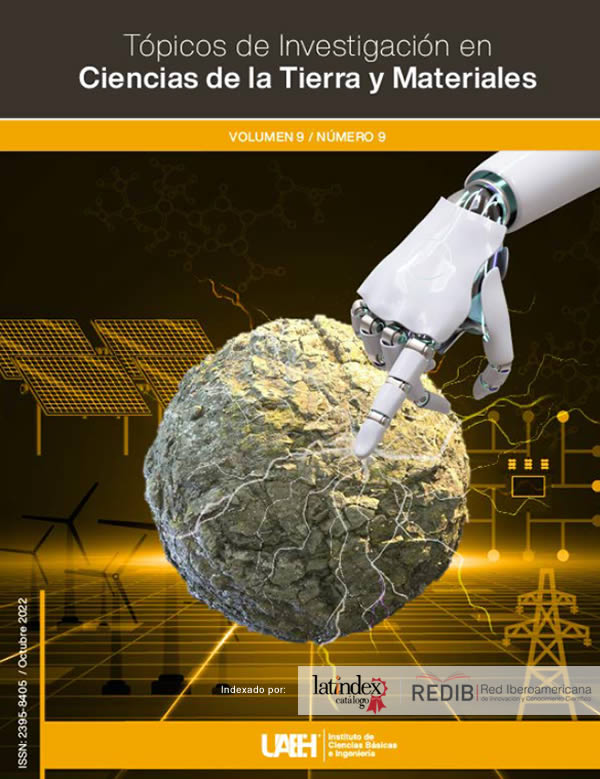Application of Electrical Resistivity Tomography (ERT) for the identification of pipe-lavas, case study: El Quebracho, Tulancingo, Hidalgo, Mexico.
Abstract
The town of Huajomulco in the municipality of Tulancingo in Hidalgo State, there is a cavity in the subsoil called "El Quebracho", which geologically has features of lava tube or also called tube-lava, generated due to spills of viscous lava of basaltic type. Electrical Resistivity Tomography (ERT) is a tool by which the terrain is characterized through several measurements of electrical potential along the terrain, having as an answer the different resistivity values of each of the materials of the terrain, in this case it was used to determine and characterize the structure that suggests to be a lava-tube. Five 2D resistivity profiles were obtained along which the structure was identified, as well as geoelectric units, morphology, lithology and the different subsoil materials.
According to the resistivity results obtained with the SRT, it was possible to obtain favorable results for 2D characterization of the tube-lava, proving the versatility of the method when applied. This methodology can be used in subsequent studies to determine the geological context of the subsoil and evaluate the geological risks in the locality due to the existence of a possible Tube-lava system.
Downloads
References
Castro García A. (1991). Geología volcánica de la región de Tulancingo, Estado de Hidalgo (Tesis de Ingeniería). Universidad Nacional Autónoma de México.
Constantino Rodríguez, L. D. (2011). Método de Tomografía Eléctrica para determinar Estructuras Volcánicas (Tesina de Licenciatura). Universidad Nacional Autónoma de México.
Criterio. (2022). Desazolvar presas permitirá revertir déficit de acuífero. 31 de Mayo de 2022, de Criterio Sitio web: https://criteriohidalgo.com/regiones/desazolvar-presas-permitiria-revertir-deficit-de-acuifero
Daza Brunet, R. (2015). Distribución, composición y génesis (biótica/abiótica) de los espeleotemas de las cuevas volcánicas de la Isla Terceira (Azores, Portugal) (Tesis de doctorado). Universidad Complutense de Madrid, Madrid.
Detay, M. y Hróarsson, B. (2011). Túneles de lava. Investigación y ciencia, (420), 62-67. Recuperado 23 de agosto de 2021, de https://www.investigacionyciencia.es/revistas/investigacion-y-ciencia/la-fsica-de-la-inteligencia-533/tneles-de-lava-9131.
Dóniz, J., Coello, E., Romero, C., & Guillén, C. (2007). Valoración del patrimonio geomorfológico del tubo volcánico de Montaña del Castillo (Tenerife, Canarias). Minius, 15, 85-94.
González Pimentel, J. L. (2019). Microorganismos de las cuevas volcánicas de la palma (islas canarias): diversidad y potencial uso biotecnológico (Tesis de Doctorado). Universidad Pablo de Olavide, Sevilla.
Hill, CA y Forti, P. (1995). La clasificación de los minerales de cuevas y espeleotemas. Revista Internacional de Espeleología , 24 (1), 5.
Orellana, , E. (1972). Prospección geoeléctrica en corriente continua (Vol. 1). Madrid: Paraninfo.
Pedromo S., 2009. Tomografía eléctrica en apoyo de la investigación arqueológica (Tesis de Licenciatura). Facultad de Ciencias Astronómicas y Geofísicas. Universidad Nacional de La Plata. p. 43.
Pérez Corona, F. Y. (2011). Caracterización geofísica de ambientes cársticos, caso: Poljé de Joya de Luna, San Luis Potosí, México (Tesis de Maestría). Instituto Potosino de Investigación Científica y Tecnológica, San Luis Potosí.
Ramírez T. E., Uribe L. J., Galeana G. O. A., Torres R. M., Bahena E. F. M. y Luna C. H. F. 2016. Informe y carta geológico-minera Tulancingo, F14-D82, escala 1:50 000, estado de Hidalgo. Servicio Geológico Mexicano.
Redacción. (2017). Autoridades realizan revisión de tubos volcánicos del municipio.. 31 de Mayo de 2022, de NQRadio Sitio web: http://nqradio.com/2017/10/12/autoridades-realizan-revision-de-tubos-volcanicos-del-municipio/
SGM (Servicio Geológico Mexicano). (2011). Ordenamiento Ecológico Territorial de la Región Tulancingo
Copyright (c) 2022 Bryan Isaac Moreno Rivera, Fred Yoan Pérez Corona, Ingrid Arcega Santillán, Diego Ignacio Juárez Alvarado

This work is licensed under a Creative Commons Attribution-NonCommercial-NoDerivatives 4.0 International License.












